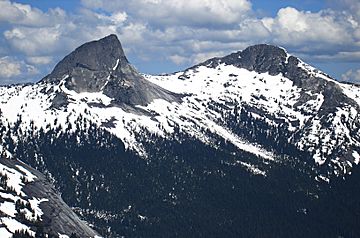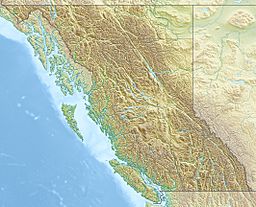Guanaco Peak facts for kids
Quick facts for kids Guanaco Peak |
|
|---|---|

Vicuna Peak (left) with Guanaco Peak (right)
|
|
| Highest point | |
| Elevation | 2,127 m (6,978 ft) |
| Prominence | 1,002 m (3,287 ft) |
| Parent peak | Stoyoma Mountain (2267 m) |
| Geography | |
| Location | British Columbia, Canada |
| Parent range | North Cascades |
| Topo map | NTS 92H/11 |
| Climbing | |
| First ascent | 1981 Karl Ricker, BCMC Party |
| Easiest route | Southwest Ridge class 3 |
Guanaco Peak is a tall mountain in British Columbia, Canada. It stands about 2,127 meters (or 6,978 feet) high. This peak is part of the North Cascades mountain range. It is the tallest summit in a group of mountains known as the Anderson River Group.
Guanaco Peak is located about 8 kilometers (5 miles) northwest of Coquihalla Summit. It is also about 1 kilometer (0.6 miles) northeast of Vicuna Peak. Rain and melting snow from the mountain flow into two different rivers. On the west side, water drains into the East Anderson River. On the east side, it flows into the Coldwater River.
The mountain was named after the guanaco, an animal similar to a llama. This name was suggested in 1974 by Philip Kubik, who was part of the first group to climb the mountain. Many other nearby peaks also have animal names. The name "Guanaco Peak" became official on February 5, 1976. This was decided by the Geographical Names Board of Canada.
How Guanaco Peak Was Formed
The Cascade Mountains, including Guanaco Peak, started forming millions of years ago. This happened during a time called the late Eocene Epoch. The North American Plate (a huge piece of Earth's crust) slowly moved over the Pacific Plate. This movement caused many volcanic eruptions.
Small pieces of Earth's crust, called terranes, also came together. These pieces helped create the North Cascades about 50 million years ago.
Ice and Earthquakes
Over two million years ago, during the Pleistocene period, glaciers covered the land. These huge sheets of ice moved forward and then melted back many times. As they moved, they carved out the landscape. This is why river valleys in the area often have a "U" shape.
The mountains also grew taller because of processes called uplift (when land pushes up) and faulting (when cracks in the Earth's crust move). These movements, along with the glaciers, created the tall peaks and deep valleys we see in the North Cascades today.
The North Cascades has some of the most rugged land in the Cascade Range. It features sharp peaks, rocky ridges, deep glacial valleys, and tall granite spires. All these geological events created different types of land. This also led to different climates and types of plants in the area.
Climate Around Guanaco Peak
Guanaco Peak is in a marine west coast climate zone. This means it gets a lot of moisture from the Pacific Ocean. Most weather fronts (areas where different air masses meet) come from the Pacific. They travel east towards the Cascade Range. When they hit the mountains, the air is forced to rise. This process, called Orographic lift, makes the air cool down and drop its moisture.
Because of this, the Cascade Mountains get a lot of rain and snow. Winters can be very cold, with temperatures dropping below −20 °C. With the wind, it can feel even colder, sometimes below −30 °C. The best time to climb Guanaco Peak is usually from July through September. During these months, the weather is more pleasant.





